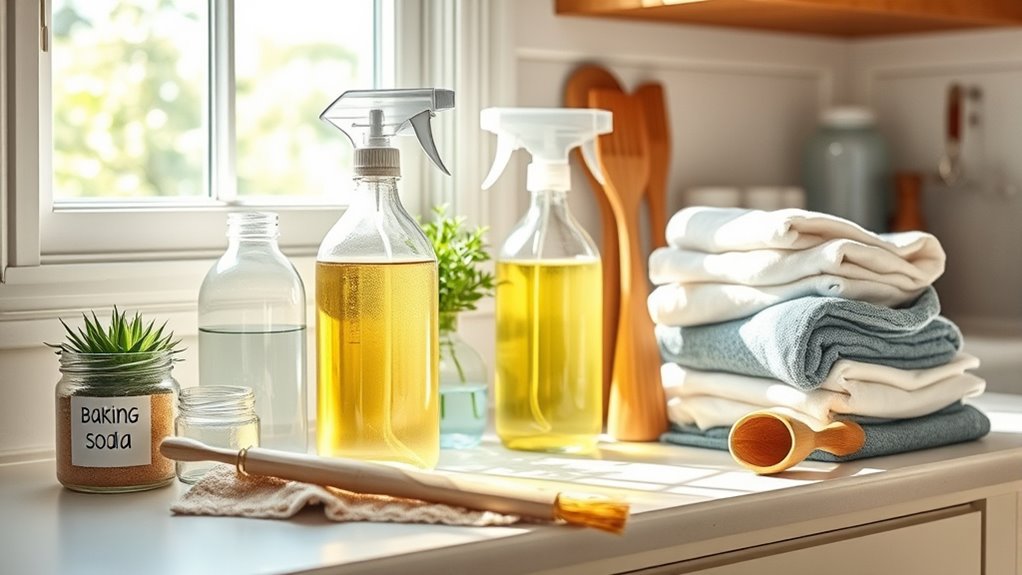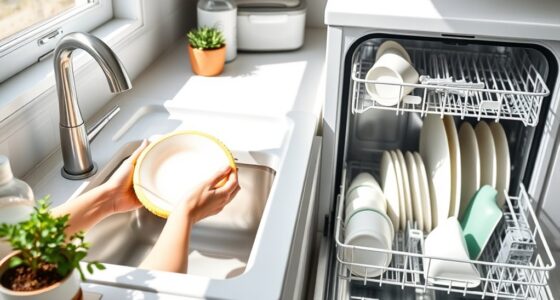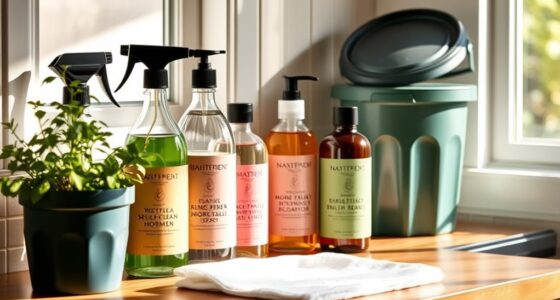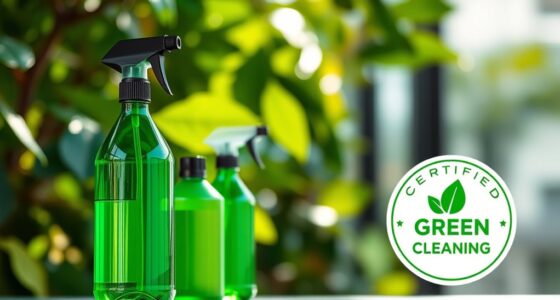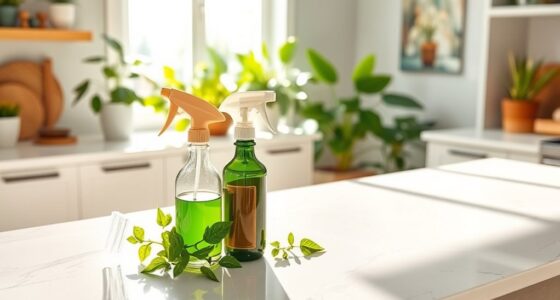To reduce plastic in your cleaning routine, switch to eco-friendly packaging by choosing products made with recycled or biodegradable materials. Use refillable containers and take advantage of bulk refill stations to cut down on packaging waste. You can also make simple homemade cleaners with vinegar, baking soda, or lemon juice stored in reusable bottles. These small steps help minimize plastic use and support sustainable habits—keep going to discover more effective ways to green your routine.
Key Takeaways
- Choose eco-friendly packaging by selecting products with recycled or biodegradable materials.
- Use refillable containers and refill stations to minimize single-use plastic waste.
- Make homemade cleaning solutions with natural ingredients to reduce packaging and chemical use.
- Opt for durable, reusable containers made from glass or stainless steel for long-term use.
- Support brands committed to sustainable practices and reducing plastic packaging.

Many people are looking for ways to make their cleaning routines more eco-friendly, and reducing plastic waste is a great place to start. One effective method is switching to products that use sustainable packaging. Instead of buying cleaners in single-use plastic bottles, look for brands that prioritize eco-conscious packaging options. These often come in recycled or biodegradable materials, which lessen the environmental impact. By choosing products with sustainable packaging, you help reduce the demand for virgin plastics and support companies committed to greener practices.
Another powerful step is using refillable containers for your cleaning supplies. Instead of constantly purchasing new bottles, invest in durable, reusable containers that can be refilled multiple times. This not only cuts down on plastic waste but also saves you money over time. Many stores now offer bulk refills of common cleaning products, allowing you to fill your containers directly at the store or at designated refill stations. This approach minimizes packaging waste and decreases the energy involved in manufacturing and transporting new bottles.
Switching to refillable containers also encourages a more mindful approach to cleaning. You become more aware of the quantities you use and can better control the amount of product dispensed, reducing excess and waste. Plus, using refillable containers often means you’re choosing products with fewer preservatives and additives, as many bulk or refill options are more straightforward and less heavily packaged than their pre-filled counterparts.
To make this transition easier, keep a few high-quality refillable containers in your home. Label them clearly to avoid confusion and ensure you’re always using the right product for each task. Look for containers made from durable, non-toxic materials like glass or stainless steel—they’re safer, last longer, and are easier to clean. When shopping, prioritize brands that offer refill options or bulk sizes designed for reuse. This way, you’re actively reducing your plastic footprint with every purchase.
In addition to using sustainable packaging and refillable containers, consider making your own cleaning solutions at home. Many recipes require simple ingredients like vinegar, baking soda, and lemon juice, which you can store in your refillable bottles. Not only does this cut down on packaging waste, but it also reduces the number of chemicals in your home. Overall, these small but impactful changes help you create a cleaning routine that’s kinder to the environment while still keeping your space spotless.
Frequently Asked Questions
Are There Eco-Friendly Alternatives to Plastic Cleaning Bottles?
Yes, you can find eco-friendly alternatives to plastic cleaning bottles. Opt for refillable bottles made from durable, biodegradable plastics that break down naturally over time. These bottles allow you to reuse them repeatedly, reducing waste. Look for brands that prioritize sustainable packaging and use biodegradable plastics. By choosing these options, you’ll cut down on plastic waste and make your cleaning routine more eco-conscious.
How Can I Recycle Plastic Cleaning Containers Properly?
Oh, recycling plastic containers is just too complicated, right? Not really! You just rinse your plastic container thoroughly, check for recycling symbols, and then place it in your local recycling bin for plastic container recycling. For cleaning product disposal, never pour leftover chemicals down the drain—find a hazardous waste facility. Simple steps like these keep plastics out of landfills and guarantee your cleaning habits are eco-friendly.
Can I Make My Own Cleaning Products at Home?
Yes, you can make your own cleaning products at home using natural ingredients. Homemade solutions like vinegar, baking soda, and lemon juice work effectively and are eco-friendly. You’ll avoid plastic containers and harmful chemicals, reducing waste and environmental impact. Simply mix these natural ingredients in reusable bottles to create safe, inexpensive cleaners. This way, you keep your home clean while actively reducing plastic use and supporting sustainability.
What Brands Offer Sustainable Cleaning Supplies?
You can choose brands like Seventh Generation, Blueland, and Grove Collaborative that prioritize sustainability. They offer cleaning supplies in biodegradable packaging and refillable containers, helping you cut down on plastic waste. By selecting these brands, you support eco-friendly practices and reduce your environmental impact. Look for products labeled with refillable options and biodegradable materials to make your cleaning routine more sustainable and eco-conscious.
Are Plastic-Free Cleaning Options as Effective?
You’ll find that plastic-free cleaning options, like plant-based cleaners in biodegradable packaging, are just as effective as traditional products. Studies show eco-friendly cleaners can match or surpass conventional ones in cleaning power. These alternatives often contain natural ingredients that break down easily, reducing environmental impact. You’ll value that switching to plant-based cleaners helps protect ecosystems, and the biodegradable packaging guarantees waste decomposes quickly, making your cleaning routine greener and just as efficient.
Conclusion
By choosing eco-friendly options, you’re turning the tide against plastic pollution, transforming your cleaning routine into a wave of change. Every refill and reusable bottle becomes a ripple that spreads awareness and sparks action. As you embrace sustainable habits, you’re weaving a tapestry of environmental care, one cleaning session at a time. Together, your mindful choices flow like a gentle river, carving a clearer, cleaner future—where plastic waste is just a distant memory.

